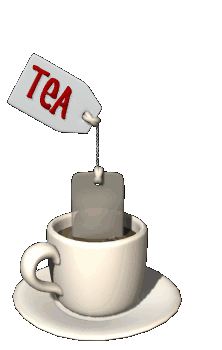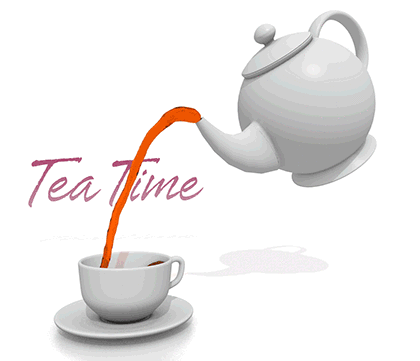

Tea Time
Tea Time


English Tea- Paul McCartney Lyrics

Pete Castle sings The Good old English cup of tea

Why Britain Loves Tea
People visiting Britain often think that the British have tea at a particular time each day - usually 4 o'clock. They also think that there is the same tea ceremony performed in every home. We drink over 150 million cups of tea a day in Britain, but there is no special time for the nation’s favourite drink. It can be at 4 o'clock or it can be later in the afternoon and even extend into early evening.
‘Tea’ is widely used as a name for the evening meal. This is more common in Scotland and the north of England but you can hear it all over the country. Usually it is the main meal of the day, eaten between 5 and 7. So, ‘teatime’ refers to the meal and not the drink. In the south, the evening meal is often called dinner, while dinner in the north is the midday meal. Confused? Many heated debates can happen between southerners and northerners about the right name, but in general:
North: Breakfast - Dinner - Teatime
South: Breakfast - Lunch - Dinner









There are afternoon tea and high tea. What Is the Difference Between Afternoon Tea and High Tea? Afternoon tea is a British food tradition of sitting down for an afternoon treat of tea,sandwich, scones and cake. When afternoon tea became fashionable in the early 19th century thanks to the Anna, the Duchess of Bedford, it was never intended to replace dinner but rather to fill in the long gap between lunch and dinner at a time when dinner was served as late as 8 p.m. Lifestyles have changed since those times and afternoon tea is now a treat, rather than a stop-gap. The working lives of many do not allow the time to sit down to enjoy scones and cakes in the late afternoon, so for many, the ritual is now saved for holiday and special treat. The tradition is still quintessentially British, and many Brits still make time to sit and enjoy the propriety and civility of this the quaintest of English dining customs, just not on a daily basis.
The origins of afternoon tea show clearly it was the preserve of the rich in the 19th century. For workers in the newly industrialized Britain, tea time had to wait until after work.
By that hour, tea was generally served with heartier dishes which were substantially more than just tea and cakes. Workers needed sustenance after a day of hard labor, so the after-work meal was more often hot and filling and accompanied by a pot of good, strong tea to revive flagging spirits.Today, the evening meal in working class households is still often called "tea" but as working patterns have changed yet again, many households now refer to the evening meal as supper.The addition of the word "high" to the phrase "high tea" is believed to differentiate between the afternoon tea that is traditionally served on low, comfortable, parlor chairs or relaxing in the garden and the worker’s after-work high tea that is served at the table and seated on high back dining chairs.


Nor is tea the same meal in every home. The typical image people have of tea time in Great Britain can be seen in the tea room in Fortnum and Mason's, the great shop near Picadilly in London. Here tea is served with style and lots of cakes. There is a huge choice of tea blends and expert advice on the different tastes of the blends. People are on their best behaviour and dress very smartly. It is very like "Downton Abbey".

This experience of tea-time is however quite rare outside tea-rooms. In British homes you do not have the beautiful sandwiches, the many cakes, the delicate and attractive tea service every day.On special occasions or when people are invited to tea - the best tea service is brought out and cakes and sandwiches are produced.
Away from Fortnum and Masons tea can be a very different meal. For example, people have "high tea". In the west of England this is the main hot meal of the day and it is usually at 6 o'clock in the evening. People drink tea at this meal- usually strong black tea and they rarely experiment with exotic tea blends.
There are other kinds of tea. In Cornwall it is very common to have a cream tea. Instead of sandwiches and cakes you serve scones with clotted cream and strawberry jam. It is very popular with tourists and quite delicious!
Tea-time in Britain is often a time to relax and chat with family and friends. Indeed tea generally has become a very different meal from the quite formal experience that you see in Fortnum and Mason and on television programmes like Downton Abbey.
A famous English writer once commented that the English began to decline as a people the moment they stopped drinking beer and started drinking tea. One thing is certain: tea as a drink or a meal is as popular as it has ever been.



